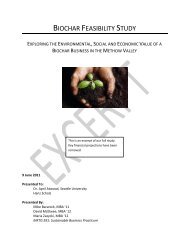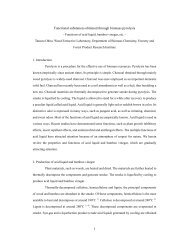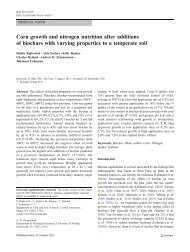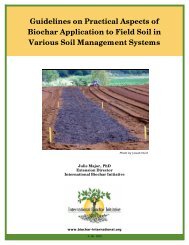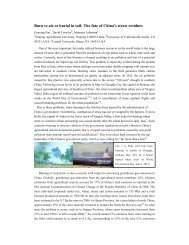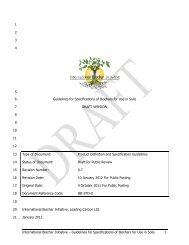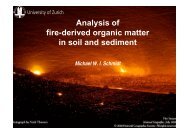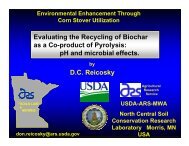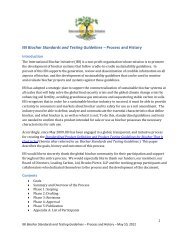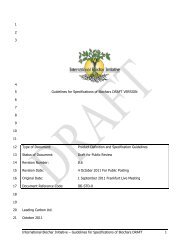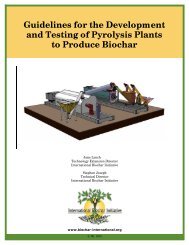International Biochar Initiative â Product Definition and Standard ...
International Biochar Initiative â Product Definition and Standard ...
International Biochar Initiative â Product Definition and Standard ...
You also want an ePaper? Increase the reach of your titles
YUMPU automatically turns print PDFs into web optimized ePapers that Google loves.
Examples include but are not limited to petroleum products, rubber, PVC, etc.<br />
5.2 Feedstock material reporting<br />
The feedstock material(s) used to generate a biochar shall be declared by the manufacturer as<br />
discussed in Section 7.2.<br />
**Classification for feedstock materials required for product classification<br />
5.3 General <strong>Biochar</strong> process requirements<br />
The processes used to generate a biochar from the feedstock material shall:<br />
<br />
<br />
<br />
<br />
Provide a means to control the rate <strong>and</strong> extent to which the carbonisation process<br />
proceeds <strong>and</strong> therefore the residence time of feedstock in the process.<br />
Provide for a means of escape [<strong>and</strong> destruction] for air pollutants, particulates, volatile<br />
gases <strong>and</strong> derivatives from the feedstock / biochar material in a safe, effective <strong>and</strong><br />
reliable fashion during the pyrolysis process. The syngas or off-gas should be captured<br />
<strong>and</strong> at the minimum flared but optimally used as a source of energy to offset fossil fuels.<br />
The plant itself should comply with local emission <strong>and</strong> OHS st<strong>and</strong>ards.<br />
Provide a mechanism to safely <strong>and</strong> effectively arrest the pyrolysis process. The method to<br />
safely arrest the process must be an active form of suppression, such that it is capable of<br />
stopping pyrolysis of feedstock already undergoing thermal conversion. Discontinuing the<br />
supply of feedstock is not considered an active method for stopping the pyrolysis process.<br />
Maintain a desired level of consistency of the biochar production to the extent possible by<br />
limiting variations in the process conditions relative to variations in the operating<br />
environment <strong>and</strong> feedstock variability <strong>and</strong> report significant variations in consistency as<br />
described in Section 8.<br />
Further (optional) recommendations include:<br />
<br />
<br />
<br />
<br />
<br />
<br />
<strong>Biochar</strong> production shall follow all applicable laws of the country in which it occurs, <strong>and</strong><br />
shall endeavour to follow all international treaties relevant to thermal processes to which<br />
the relevant country is a party.<br />
<strong>Biochar</strong> production shall comply with local regulatory requirements that govern utilisation<br />
of the source material <strong>and</strong> production of volatile <strong>and</strong> particulate emissions.<br />
<strong>Biochar</strong> production <strong>and</strong> utilisation shall contribute to climate change mitigation by<br />
reducing GHG emissions (compared to fossil fuels) <strong>and</strong> converting labile carbon into more<br />
stable forms of carbon, including emission reductions along the complete supply chain.<br />
<strong>Biochar</strong> production shall avoid negative impacts on ecosystems, <strong>and</strong> areas human health.<br />
<strong>Biochar</strong> production shall optimize surface <strong>and</strong> groundwater resource use, including<br />
minimizing contamination or depletion of these resources, <strong>and</strong> shall not violate existing<br />
formal <strong>and</strong> customary water rights.<br />
<strong>Biochar</strong> production shall not violate l<strong>and</strong> rights.<br />
<strong>International</strong> <strong>Biochar</strong> <strong>Initiative</strong> – <strong>Product</strong> <strong>Definition</strong> <strong>and</strong> St<strong>and</strong>ard DRAFT<br />
6



